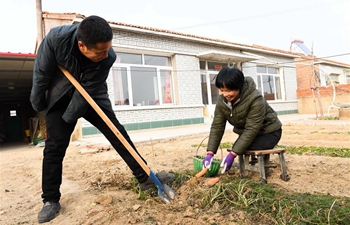by Pankaj Yadav
NEW DELHI, Dec. 4 (Xinhua) -- India is basically an agriculture-based economy as it remains among the top producers of commodities including wheat, rice, cotton, cereals, vegetables and fruits, milk and milk products. Nearly 70 percent of India's population still lives in villages and depends, directly or indirectly, on agriculture for earning a livelihood.
Agriculture contributes to the extent of 18 percent towards India's gross domestic product (GDP), even as the country accounts for nearly 7 percent of total global agricultural output.
As per the fourth advance estimates (released in August) for the year 2017-2018, total food grains production in the country was estimated at 284.83 million tons which was higher by 9.72 million tons than the previous record production of foodgrain of 275.11 million tons achieved during 2016-2017.
However, despite all this rosy picture, farmers in India are a dejected lot these days, and are venting out their anger against the government's policies, which they allege, overlook their interests and basic needs. Barely able to recover their basic costs, the farmers allege that agriculture is fast turning into an unfeasible activity.
Fed up after not being able to sell his onion produce of around 750 kg at a price more than 1.41 Indian Rupees (around 2 cents) per kg, a farmer in India's southwestern state Maharashtra sent whatever money he could receive by selling his total produce to Prime Minister Narendra Modi through a money order as a mark of protest and to highlight the farmers' plight.
Sanjay Sathe, the farmer from Maharashtra's Nasik district, reportedly said, "I produced 750 kg of onion this season but was offered a rate of one Indian rupee per kilogram at Niphad wholesale market last week. Finally I could negotiate a deal for 1.40 Indian rupees per kilogram and received 1,064 Indian rupees for 750 kg. It was painful to see such paltry returns on four months of toil. Hence I have donated 1,064 Indian Rupees to Prime Minister Disaster Relief Fund as a protest. I had to pay additional 54 Indian rupees for sending it by money order."
Interestingly, Sathe was among the selected few "progressive farmers" who were picked by the Union Agriculture Ministry in 2010 to interact with former U.S. President Barack Obama during the latter's visit.
Strangely, while on one hand, the farmers are not able to recover their bare minimum cost, on the other hand, the retailers are openly selling the same commodity at least 20 times the cost which is paid to the farmers, thereby reaping heavy profits.
Sribhagwan Singh, a farmer in Kanganheri village located in southwest Delhi, laments that he grew garlic on his farms and reaped a harvest of around 800 kg, but is not able to sell it in the market as he is getting a price of not more than 10 Indian rupees per kg.
"The bare minimum cost which I incurred in growing this garlic produce was at least 25 Indian rupees per kilogram. For over the past three months I have been contacting vendors in big vegetable markets in and around Delhi, but not able to find a buyer of my produce for more than 10 Indian rupees per kilogram. The final conclusion is that farming is a loss making entity in India, and farmers have no option but to quit it and look for some alternative source of income," he told Xinhua.
He added that the same garlic was being sold in retail market in Delhi and surrounding areas at the rate of 150 Indian rupees per kg.
Only a few days ago, thousands of farmers congregated in Delhi from across the country and carried out a two-day agitation against the central government, demanding loan waivers and increase in minimum support prices (MSPs) for their agriculture produce.
Due to big amounts of loans standing in their names and finding no possibilities of getting a stable income from agriculture, the farmers are driven to a situation where they find no alternative but to commit suicides. Farmers suicides has a major cause of concern in India for many years now, with the state of Maharashtra being on top.
The country's Agriculture Minister Radha Mohan Singh, however, claims that the number of farmers suicides in on the decline. A couple of months ago he informed the parliament that the number of farmers suicides and agricultural laborers during 2016 had come down approximately by 9.77 percent compared to the previous years.
"The number of suicides has come down from 12,602 in 2015 to 11,370 in 2016," he was quoted as saying. The maximum number of these suicides were reported from the state of Maharashtra.
The main reasons behind agriculture being a loss making activity in India is the large dependence on monsoons and lack of use of modern farming techniques. Due to non-availability of water resources round the year, a large chunk of farmers depend on monsoon rains. At times, due to poor rains, or floods caused by excess rains, standing crops get damaged thereby resulting in huge losses to the farmers.
Besides, use of traditional farming methods and non-acceptance of modern equipment and techniques, also results in poor produce in terms of yield per hectare, as compared to other countries.
In a bid to address the farmers' woes, Prime Minister Narendra Modi has announced that a new agriculture export policy will be unveiled soon to boost farm income as the government was on track to achieve the target of doubling farmers' income by 2022. The main thrust of the policy would be fixing the minimum support price (MSP) of crops at least 1.5 times of the cost of production.
The Crop Insurance Schemes have been in place as a means of protecting the agriculturist against financial losses due to uncertainties that may arise from crop failures or losses arising from named or all unforeseen perils beyond their control. One such scheme - Pradhan Mantri Fasal Bima Yojana (PMFBY) (or, Prime Minister Crop Insurance Scheme) aims at supporting sustainable production in agriculture sector by way of providing financial support to farmers suffering crop loss/damage arising out of unforeseen events; stabilizing their income to ensure their continuance in farming; encouraging farmers to adopt innovative and modern agricultural practices; ensuring flow of credit to the agriculture sector which will contribute to food security, crop diversification and enhancing growth and competitiveness of agriculture sector besides protecting farmers from production risks.
Amidst all this, the farmers community in India continues to live in abject poverty in the hope of seeing the government's polices yielding results on the ground on fine day.













